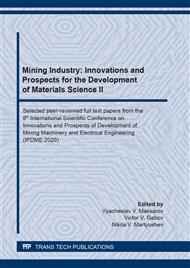[1]
Rattana B., Pusit M., Sirirat R., Yoshiharu M., Feasibility of Using TIG Welding in Dissimilar Metals between Steel, Aluminum Alloy Ener.Res. J. 1 (2) (2010) 82-86.
DOI: 10.3844/erjsp.2010.82.86
Google Scholar
[2]
Gorbach V. D., Suzdalev I. V., Sharapov M. G., The main problems of plasma-arc welding of aluminum alloys, current state and ways of solving them, Bulletin of shipbuilding technology ( 2010) 29 -39.
Google Scholar
[3]
Dowden J., Kapadia P., A mathematical investigation of the penetration depth in keyhole welding with continuous CO2 lasers, J.Phys. D: Appl. Phys. 28 (1995) 2252-2261.
DOI: 10.1088/0022-3727/28/11/005
Google Scholar
[4]
Saidaa K., Ohnishia H., Nishimoto K., Fluxless laser brazing of aluminium alloy to galvanized steel using atandem beam - dissimilar laser brazing of aluminium alloy and steels, Weld. Int. l. 24 (3) 161-168.
DOI: 10.1080/09507110902843065
Google Scholar
[5]
Kaidalov A.A., Electron-beam welding and additional technologies, Kiev: Ecotechnology. (2004).
Google Scholar
[6]
Kurganova Y.A., Influence of a discrete additive of aluminum oxide on structure and properties of aluminum alloy Journal of Mining Institute 228, (2017), 717-721.
Google Scholar
[7]
Gorlanov E.S., Brichkin V.N., Polyakov А.А., Electrolytic production of aluminium: Review. part 1. conventional areas of development Tsvetnye Metally, 2, (2020) 36-41DOI: 10.17580/tsm.2020.02.04.
DOI: 10.17580/tsm.2020.02.04
Google Scholar
[8]
Kasyanov A.V., Belousov A.E., Popov G.G., Bolobov V.I., Determination of factors affecting on grooving corrosion Topical Issues of Rational Use of Natural Resource, 1, (2019), 393-399.
DOI: 10.1201/9781003014577-49
Google Scholar
[9]
Alexandrov N.V., Blank E.D., Eroshkin S.B., Sharapov M.G., Electron beam welding of cold-resistant steels of large thicknesses, nodes of oil-producing platforms, Materials science issues 1 (97) (2019) 164-174.
DOI: 10.22349/1994-6716-2019-97-1-164-174
Google Scholar
[10]
Pryakhin E. I., Sharonov N. I., Basic provisions and problems of ELW technology for the manufacture of aluminum - magnesium alloys constructions, Journal of Mining Institute 229 (2018) 84-91.
Google Scholar
[11]
Bashenko V.V., Sharonov N.I., Features of electron beam welding of pressed-stamped aluminum alloys, Scientific and technical statements of the St. Petersburg State Polytechnic University 3 (106) (2010) 139-143.
Google Scholar
[12]
Sharonov N.I., Sharapov M.G., Control of the process of forming a welded joint in electron beam welding of aluminum alloys of increased thickness, Materials science issues 2 (94) (2018) 167-174.
Google Scholar
[13]
Karkhin V.A., Thermal processes in welding: monograph, SPb, (2013).
Google Scholar
[14]
Rao R.V., Kalyankar V.D., Multi-pass turning process parameter optimization using teaching-learning-based optimization algorithm, Scientia Iranica 20 (2013) 967-974.
DOI: 10.1016/j.scient.2013.01.002
Google Scholar
[15]
Maksarov V.V., Keksin A.I., Technology of magnetic-abrasive finishing of geometrically-complex products, IOP Conference Series: Materials Science and Engineering 327 (4) (2018).
DOI: 10.1088/1757-899x/327/4/042068
Google Scholar
[16]
Krasovskyy A., Sonnichsen S., Bachmann D., On the residual stresses in multi-pass welds: coupling of welding simulation and fatigue analysis, Procedia Engineering 10 (2011) 506-511.
DOI: 10.1016/j.proeng.2011.04.085
Google Scholar
[17]
Makarchuk A.V., Makarchuk N.V., Startsev V.N., Development of a mathematical model of multi-pass arc welding, Bulletin of the State University of Marine and River Fleet named after Admiral S. O. Makarov 9 (1) (2017) 121-131.
DOI: 10.21821/2309-5180-2017-9-1-121-131
Google Scholar
[18]
Sharonov N. I., Sharapov M. G., Modernization of the device for scanning an electron beam in electron beam welding, Materials science issues 2 (94) (2018) 161-166.
DOI: 10.22349/1994-6716-2018-94-2-161-166
Google Scholar
[19]
Zhao Hug, Han Zhong, Chen Xiao-feng, Influence of scanning on the formation of the structure of Ti-6Al-4V-joints during electron beam welding, School of Materials Science & Engineering, 26 (1) (2005) 78-80.
Google Scholar
[20]
Olshanskaya T.V., Yazovskikh V.Ya., Influence of the beam sweep on the formation of the macrostructure of the weld metal in electron beam welding with deep penetration, Perm State Technical University, Vestn. PSTU. Fur. technol. mater. and designs (1999) 225-230.
Google Scholar


